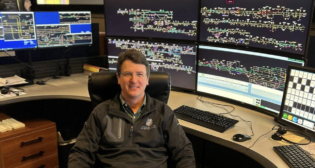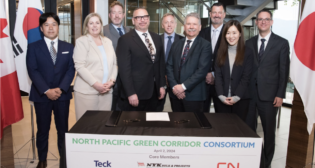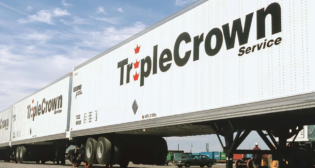
CEO PERSPECTIVE: Growing the Top Line
Written by Keith Creel, President and CEO, Canadian Pacific Kansas CityAs part of a special series in Railway Age’s March 2021 issue, 11 North American railroad CEOs address the daunting challenges the freight rail industry faces as the 21st century enters its third decade—from operations and technology to marketing and growth. Here, Keith Creel, President and CEO of Canadian Pacific, covers growing the top line as a relevant, sustainable business.
It’s fitting that we’d talk about growing the top line as 2021 gets under way. Last year, due to the COVID-19 pandemic, every Class I railway saw volumes decline. At CP, our volume fell 2% and our revenue 1%. Despite the challenging year, it was an industry-best performance I’m very proud of. As we begin this year and celebrate the 140th anniversary of CP’s incorporation, I know that the future holds great opportunity for us.
The CP family is ready to continue producing for our customers, the communities we serve, our shareholders and each other. Our strong performance during difficult times only gives me further conviction and confidence in what we can achieve in times of economic strength.
When CP began its journey of transformation back in 2012, its cost structure was unsustainable. The cost structure and our service didn’t allow us to truly compete for business. When I joined the company in 2013 as President and Chief Operating Officer, I helped to get the team focused on the fundamentals: getting the right people in the right places, identifying inefficiencies and taking out costs where we could. As a result, we improved our service and began to operate at a lower cost. Once we did that, we shifted our focus to growing the business. We encountered our share of challenges, and we didn’t get it all right, but that part of our journey was essential.
Today, I can confidently say that our value proposition lies in the service we provide. We don’t try to be everything to everyone. By combining a compelling service with the most direct routes in key lanes, we offer value to our customers. If we can cycle their cars faster than our competitors and build an expectation of reliability, we win alongside our customers.
— “Our unique land holdings are a differentiator and strength of CP’s that we’re focused on continuing to leverage to drive further top-line growth.” —
One of CP’s great successes has come from leveraging the land we have available in key markets. For example, we are working with Maersk to construct a new transload facility in the Vancouver area. Today, when ships come into the port, containers need to be trucked throughout the Vancouver area to be transloaded. We will be able to rail containers from the port directly to this new facility, eliminating the need for thousands of trucks on publicly funded roads. It’s good for the environment, good for the customer and good for CP. Land is at a premium in congested urban areas, and that’s only going to continue. Our unique land holdings are a differentiator and strength of CP’s that we’re focused on continuing to leverage to drive further top-line growth. In this situation, we identified a strategic customer that could help us make the most of a valuable real estate asset. Creating win-win solutions like this one gives customers good reasons to stick with us.
We also need to talk with our customers regularly to determine how their needs are changing and how we can best meet them. A year ago, when we saw business levels decline sharply due to the pandemic, CP Chief Marketing Officer John Brooks challenged our sales team to call each of our 500 biggest customers over a three-week period. They asked: How is the pandemic affecting your business? How have your transportation needs changed? What can we do to help you meet your needs and serve your customers?
It sounds simple, but the result was more than $20 million in business at a time when we really needed it. It reminded all of us how much power there is in asking questions and thinking critically about the answers we get. I believe the lessons we learned from having those conversations will help us emerge from the pandemic stronger than we came into it.
The Precision Scheduled Railroading (PSR) model is one that works in any environment. There’s good reason to expect 2021 will be a year of growth, but whatever the economy brings us, we have a model that will provide the foundation for us to succeed and the people who will deliver.
Throughout this pandemic, CP’s employees proved their resilience each and every day. The pride they show in their work under the most challenging of circumstances sets them apart. This franchise is blessed with unique strengths, a strong pipeline of business opportunities and the team that can deliver. That’s what gives me confidence we’re well positioned to grow the top line in 2021 and beyond.
Read more of Railway Age’s special CEO Perspectives series:
• Ian Jefferies, Association of American Railroads: Sustainable Economic and Legislative Policies
• Katie Farmer, BNSF: Leveraging Advanced Technologies
• JJ Ruest, CN: Improving Customer Supply Chain Visibility
• Jim Foote, CSX: Railroads as a Sustainable Business
• Pat Ottensmeyer, Kansas City Southern: Maximizing USMCA for Cross-Border Growth
• Jim Squires, Norfolk Southern: Building the Digital Railroad of the Future
• Lance Fritz, Union Pacific: Smart Capital Investment Strategies
• Peter Gilbertson, Anacostia Rail Holdings: Providing Outstanding Customer Service
• Dean Piacente, OmniTRAX: Building Better Communities Through Industrial Development
• Dan Smith, Watco: Integrated Transportation Services Fuel Growth



